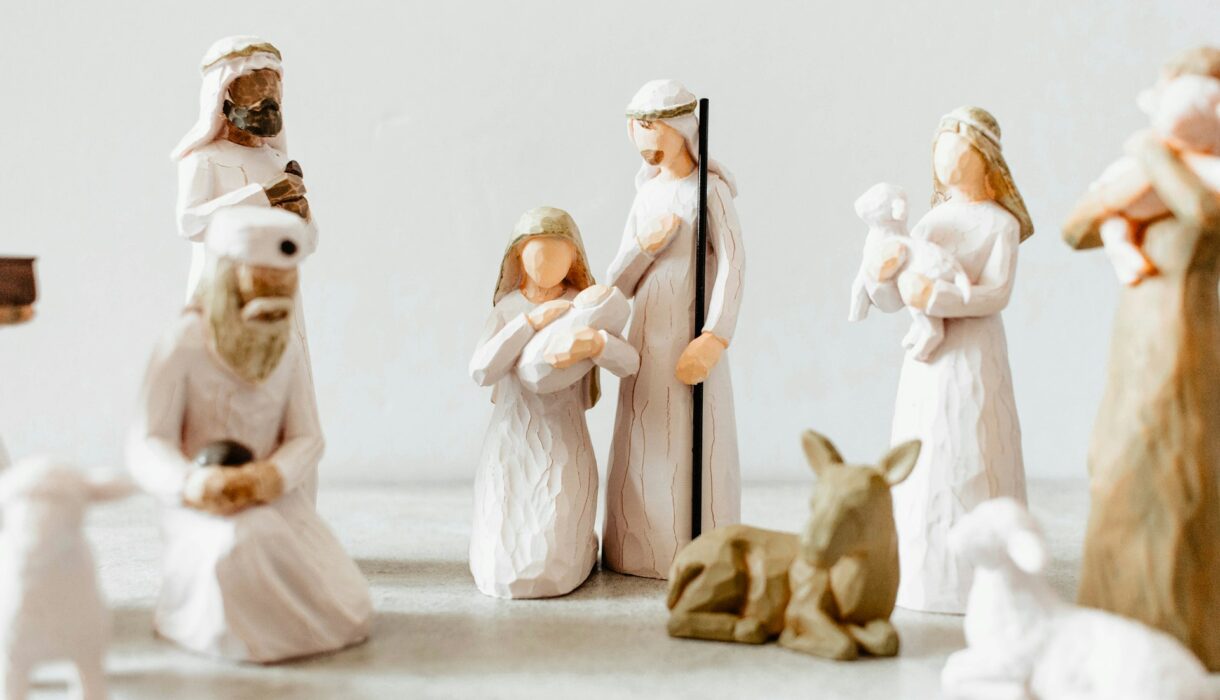
Best Sermon Series Graphics for Easter, Christmas, and Other Key Seasons
Posted in :
Seasonal sermon series represent some of the most significant opportunities for churches to connect with both regular attendees and occasional visitors. During Easter, Christmas, and other key liturgical seasons, your church likely experiences increased attendance, heightened community interest, and unique opportunities to communicate the gospel message. The visual graphics supporting these seasonal series play a crucial role in creating anticipation, reinforcing themes, and helping people connect emotionally with the spiritual significance of these important times. See how professional church graphics can strengthen your ministry’s message.
Creating compelling seasonal graphics requires balancing familiar seasonal imagery with fresh, engaging design that feels both reverent and accessible. The challenge lies in honoring tradition while avoiding clichéd or overly predictable visual treatments that might feel stale or disconnected from your specific community. The most effective seasonal graphics capture the theological depth of these celebrations while remaining visually compelling and easily understood by people at various stages of their spiritual journey.
Understanding Seasonal Design Psychology
Different seasons carry distinct emotional and spiritual associations that should inform your graphic design choices. Spring seasons like Easter naturally connect with themes of renewal, growth, and new life, making fresh greens, soft pastels, and organic imagery particularly effective. However, Easter also encompasses the gravity of Christ’s suffering, requiring design approaches that can honor both the solemnity of Good Friday and the celebration of resurrection.
Winter seasons, particularly Christmas and Advent, often benefit from warmer color palettes that create feelings of comfort, intimacy, and celebration despite the cold weather. Deep reds, rich golds, and warm candlelight imagery can create inviting visual atmospheres that draw people into the story of Christ’s incarnation. However, contemporary churches might choose cooler, more modern color schemes that feel fresh while still honoring the season’s significance.
The key is understanding your community’s expectations and traditions while finding ways to present familiar themes with visual freshness. A traditional liturgical church might appreciate classical imagery reinterpreted with modern design techniques, while a contemporary congregation might respond better to abstract representations of seasonal themes that feel current and relevant.
Easter Series Graphics: Balancing Death and Resurrection
Easter sermon series graphics face unique challenges in representing both the suffering of Christ and the celebration of resurrection within cohesive visual systems. The most effective approaches create visual journeys that acknowledge the complete Easter story rather than focusing exclusively on either crucifixion or resurrection imagery.
Progressive visual storytelling can carry audiences through the Easter narrative using evolving graphic elements. Your series might begin with darker, more subdued imagery representing Lent and Holy Week, gradually transitioning to brighter, more celebratory visuals as the series moves toward resurrection Sunday. This progression helps congregants experience the emotional and spiritual journey of the season through visual design.
Color progression offers powerful ways to represent Easter themes. Starting with deeper purples and somber tones associated with Lent, moving through the stark blacks and grays of Good Friday, and culminating in bright golds, whites, and vibrant colors for resurrection creates visual momentum that supports the theological narrative. However, ensure your color choices work across all planned applications—what looks dramatic on projection screens must also work for print bulletins and social media posts.
Symbolic imagery for Easter requires careful consideration to avoid overused visual clichés while maintaining clear communication. Instead of obvious crosses and lilies, consider more subtle representations: empty tomb imagery, sunrise symbolism, stone and light contrasts, or abstract representations of transformation and new life. The goal is creating fresh visual approaches to familiar themes that invite deeper contemplation rather than automatic dismissal.
Typography choices for Easter graphics should reflect both the gravity and the joy of the season. Bold, confident fonts can represent the victory of resurrection, while more elegant, classical typefaces might honor the traditional significance of the celebration. Script fonts can add warmth and personal connection but should be used sparingly to maintain readability across different platforms and viewing distances.
Christmas Series Graphics: Warmth, Wonder, and Worship
Christmas sermon series graphics must navigate the intersection of cultural celebration and spiritual significance, creating visual approaches that honor the incarnation while remaining accessible to visitors who might be attending church specifically for Christmas services. The challenge lies in differentiating your church’s Christmas graphics from generic holiday imagery while maintaining the warmth and accessibility that draws people to Christmas celebrations.
The incarnation theme offers rich visual possibilities beyond traditional nativity imagery. Consider focusing on concepts like “light coming into darkness,” “God with us,” or “heaven meeting earth.” These themes can be represented through abstract light and shadow play, architectural elements that suggest divine/human intersection, or contemporary interpretations of ancient symbols.
Advent series require different visual approaches than Christmas Day celebrations. Advent graphics might emphasize anticipation, waiting, and preparation through more subdued color palettes and imagery suggesting expectation rather than fulfillment. Purple and blue traditional Advent colors can be modernized through contemporary design treatments while maintaining their symbolic significance.
Family-friendly Christmas graphics should be engaging for children while remaining sophisticated enough for adult appreciation. This might mean incorporating playful elements like stars, angels, or gift imagery in ways that feel fresh rather than childish. Consider how your graphics will work for church-wide events that include multiple generations and various levels of church familiarity.
Cultural sensitivity becomes particularly important during Christmas when churches often welcome visitors from different faith backgrounds or those uncomfortable with overtly religious imagery. Your graphics should be clearly Christian without being exclusionary, inviting rather than confrontational, and focused on the hope and peace of Christ’s coming rather than cultural battle imagery.
Advent: Building Anticipation Through Visual Progression
Advent sermon series offer unique opportunities for progressive visual storytelling that builds anticipation over the four-week season. Unlike single-event celebrations, Advent graphics must maintain visual coherence while showing development and building toward Christmas celebrations.
Candle imagery remains one of the most effective visual frameworks for Advent series, but contemporary treatments can refresh this traditional symbol. Consider abstract light progression, modern candle photography, or graphic interpretations of increasing illumination. The key is showing visual progression that mirrors the spiritual journey of preparation and anticipation.
Traditional Advent themes—Hope, Peace, Joy, and Love—provide content structure for your visual system. Each week might feature different color emphasis within your overall palette, distinct but related imagery, or progressive design elements that build toward a complete Christmas graphic. This approach helps congregation members follow the series progression while creating anticipation for the final celebration.
Advent calendar concepts can translate into effective graphic systems for churches, creating visual countdowns that build excitement throughout the season. These might be literal calendar imagery or more abstract representations of progression and building anticipation. Social media implementations of advent calendar graphics can drive ongoing engagement throughout the season.
Lent: Visual Simplicity and Spiritual Depth
Lenten sermon series graphics require different approaches than celebratory seasonal graphics, emphasizing simplicity, reflection, and spiritual preparation. The traditional Lenten emphasis on fasting, prayer, and almsgiving translates into visual design principles that prioritize clarity over decoration and depth over surface appeal.
Minimalist design approaches often work particularly well for Lent, using more white space, simpler color palettes, and fewer decorative elements. This visual restraint can create space for contemplation and reflection while avoiding the visual complexity that might distract from serious spiritual themes like repentance, discipline, and preparation.
Purple, the traditional liturgical color for Lent, offers rich possibilities for contemporary design treatments. Deep, royal purples can feel elegant and sophisticated, while lighter lavenders might feel more accessible and less intimidating. Consider how purple interacts with your church’s existing brand colors and whether you need to adjust your usual palette for the season.
Desert and wilderness imagery connects with traditional Lenten themes of testing, preparation, and spiritual journey. However, avoid imagery that feels harsh or unwelcoming—the goal is conveying serious spiritual themes while maintaining the hope and grace that define Christian faith. Abstract representations of journey, growth, and preparation might work better than literal wilderness photography.
Pentecost and Summer Series: Energy and Growth
Pentecost and summer sermon series graphics can embrace energy, movement, and growth themes that might feel inappropriate during more contemplative seasons. Fire imagery, wind representations, and dynamic visual elements can represent the Holy Spirit’s movement while creating engaging graphics for what is often considered a slower church season.
Red, the traditional Pentecost color, provides opportunities for bold, energetic design approaches. However, consider how extensive red usage might feel overwhelming or aggressive in your specific context. Combining red with cooling blues or fresh greens can create more balanced palettes while maintaining the energy associated with Pentecost themes.
Summer series often focus on practical Christian living, church growth, or community engagement themes that benefit from more relaxed, accessible visual approaches. Outdoor imagery, community photography, or lifestyle-focused graphics can support these themes while maintaining professional quality and clear communication.
Back-to-School and Fall Series: Wisdom and Learning
Fall sermon series, particularly those coinciding with back-to-school seasons, often emphasize themes of wisdom, learning, and spiritual growth. These themes translate well into visual approaches that feel academic without being overly intellectual or intimidating to visitors.
Autumn color palettes offer rich possibilities for church graphics, but avoid falling into predictable orange-and-brown combinations. Consider deeper, more sophisticated autumn colors—burgundy, forest green, golden yellow, and rich brown—that feel mature and inviting. These colors work particularly well for churches emphasizing theological depth and spiritual maturity.
Book and learning imagery must be handled carefully to avoid appearing exclusionary to people who might feel intimidated by academic approaches to faith. Consider more abstract representations of growth, discovery, and wisdom that invite participation rather than suggesting prerequisite knowledge or education levels.
Planning Seasonal Graphics Systems
Successful seasonal graphics require advance planning that considers all applications and touchpoints where your church community will encounter these visual elements. Create comprehensive lists of needed graphics before beginning design work: social media posts, website banners, projection backgrounds, print bulletins, signage, promotional materials, and any special event graphics.
Establish consistent design systems that can adapt across multiple formats while maintaining visual coherence. Your Easter series graphics should work equally well as Instagram squares, website headers, and large-format church banners. This requires planning for different aspect ratios, text scaling, and color variations while maintaining recognizable visual identity.
Consider production timelines and approval processes when planning seasonal graphics. Major seasonal series often require earlier planning than regular sermon series, both because of increased community expectations and because seasonal imagery might require more complex design development. Build in time for revisions, feedback, and production of all needed materials.
Budget considerations for seasonal graphics might differ from regular series, particularly if you’re planning special print materials, large-format displays, or enhanced digital presentations. Plan these costs in advance and consider which elements are most crucial for effective communication versus nice-to-have enhancements.
Technical Considerations for Seasonal Graphics
Seasonal graphics often receive higher visibility and broader distribution than regular sermon series graphics, making technical quality particularly important. Ensure your graphics work effectively across all planned applications, from small social media thumbnails to large sanctuary projections.
Color management becomes crucial when seasonal graphics will be used across multiple platforms and print applications. Test your graphics on various devices and in different lighting conditions to ensure colors translate appropriately. What looks perfect on your computer monitor might appear differently on church projection systems or in printed bulletins.
File organization and version control are essential for seasonal campaigns that might include dozens of individual graphics across multiple formats. Establish clear naming conventions and folder structures that allow easy access to needed files throughout the season and for future reference.
Archive successful seasonal graphics for future reference and potential reuse. While you shouldn’t simply repeat previous years’ designs, successful seasonal graphics can provide starting points for future development and help maintain consistency in your church’s seasonal visual identity over time.
Measuring Seasonal Graphics Effectiveness
Evaluate the success of your seasonal graphics beyond aesthetic appreciation. Consider engagement metrics for social media posts, attendance patterns for advertised events, and feedback from congregation members and visitors about the clarity and appeal of your seasonal communications.
Seasonal series often provide opportunities for A/B testing different graphic approaches with larger sample sizes than regular sermon series. Consider testing different color approaches, imagery styles, or text treatments to understand what resonates most effectively with your specific community.
Document lessons learned from each seasonal campaign to inform future planning. What graphics generated the most positive response? Which design approaches supported your theological themes most effectively? What technical or logistical challenges emerged that could be avoided in future seasons?
Conclusion
Seasonal sermon series graphics represent significant opportunities to support your church’s most important celebrations and teaching emphasis throughout the year. The most effective seasonal graphics balance respect for tradition with contemporary relevance, creating visual communications that honor the depth of these celebrations while remaining accessible and engaging for diverse audiences.
Success in seasonal graphic design comes from understanding both the theological significance of these seasons and the practical needs of your specific church community. Whether your approach emphasizes traditional imagery with contemporary treatments or completely fresh visual interpretations of familiar themes, the goal remains consistent: creating graphics that support spiritual engagement, community connection, and effective communication of the gospel message.
The investment in thoughtful, well-executed seasonal graphics pays dividends in enhanced worship experiences, clearer communication, and stronger community engagement during your church’s most significant celebrations. By planning ahead, maintaining consistent quality standards, and focusing on authentic representation of your church’s heart and theology, your seasonal graphics can become powerful tools for ministry and community building throughout the liturgical year.

